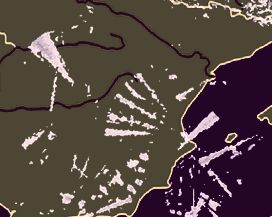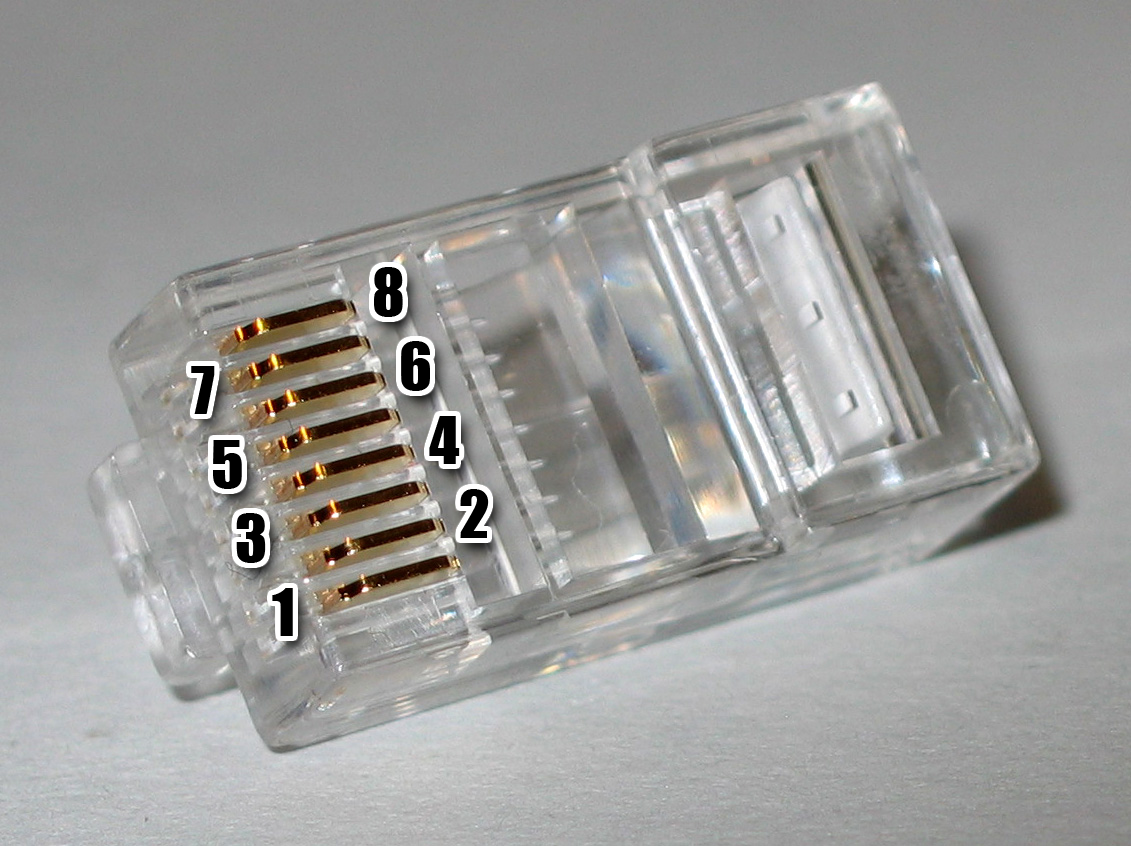|
Category 6 Cable
Category 6 cable (Cat 6) is a standardized twisted pair cable for Ethernet and other network physical layers that is backward compatible with the Category 5/5e and Category 3 cable standards. Cat 6 must meet more stringent specifications for crosstalk and system noise than Cat 5 and Cat 5e. The cable standard specifies performance of up to 250 MHz, compared to 100 MHz for Cat 5 and Cat 5e. Whereas Category 6 cable has a reduced maximum length of when used for 10GBASE-T, Category 6A cable is characterized to 500 MHz and has improved alien crosstalk characteristics, allowing 10GBASE-T to be run for the same maximum distance as previous Ethernet variants. History Cat 6, an unshielded twisted-pair (UTP) design, emerged as an advancement of the UTP Cat 5e, and was formalised in 2001. The design of Cat 6 required more stringent precision in manufacturing, and this enabled reduced noise and crosstal ... [...More Info...] [...Related Items...] OR: [Wikipedia] [Google] [Baidu] |
Copper-clad Aluminium Wire
Copper-clad aluminium wire (CCAW or CCA) is a dual metal electrical conductor composed of an inner aluminium core and outer copper cladding. Uses The primary applications of this conductor revolve around weight reduction requirements. These applications include high-quality coils, such as the voice coils in headphones or portable loudspeakers; high frequency coaxial applications, such as RF antennas and cable television distribution cables; and power cables. CCA was also used in electrical wiring for buildings. The copper/aluminium construction was adopted to avoid some of the problems with aluminium wire, yet retain most of the cost advantage. CCA is also seen in counterfeit unshielded twisted pair networking cables. These cables are often less expensive than their full-copper counterparts, but the official specifications such as Category 6 cable require conductors to be pure copper. This has exposed the manufacturers or installers of cable with fake certification to legal ... [...More Info...] [...Related Items...] OR: [Wikipedia] [Google] [Baidu] |
IEEE
The Institute of Electrical and Electronics Engineers (IEEE) is a 501(c)(3) professional association for electronic engineering and electrical engineering (and associated disciplines) with its corporate office in New York City and its operations center in Piscataway, New Jersey. The mission of the IEEE is ''advancing technology for the benefit of humanity''. The IEEE was formed from the amalgamation of the American Institute of Electrical Engineers and the Institute of Radio Engineers in 1963. Due to its expansion of scope into so many related fields, it is simply referred to by the letters I-E-E-E (pronounced I-triple-E), except on legal business documents. , it is the world's largest association of technical professionals with more than 423,000 members in over 160 countries around the world. Its objectives are the educational and technical advancement of electrical and electronic engineering, telecommunications, computer engineering and similar disciplines. History Origin ... [...More Info...] [...Related Items...] OR: [Wikipedia] [Google] [Baidu] |
Ground Loop (electricity)
In an electrical system, a ground loop or earth loop occurs when two points of a circuit are intended to have the same ground reference potential but instead have a different potential between them. This is typically caused when enough current is flowing in the connection between the two ground points to produce a voltage drop and cause two points to be at different potentials. Current may be produced in a circular ground connection (ground loop) by electromagnetic induction. Ground loops are a major cause of noise, hum, and interference in audio, video, and computer systems. Wiring practices that protect against ground loops include ensuring that all vulnerable signal circuits are referenced to one point as ground. The use of differential signaling can provide rejection of ground-induced interference. Removal of safety ground connections to equipment in an effort to eliminate ground loops also eliminates the protection the safety ground connection is intended to provide. ... [...More Info...] [...Related Items...] OR: [Wikipedia] [Google] [Baidu] |
Electromagnetic Interference
Electromagnetic interference (EMI), also called radio-frequency interference (RFI) when in the radio frequency spectrum, is a disturbance generated by an external source that affects an electrical circuit by electromagnetic induction, electrostatic coupling, or conduction. The disturbance may degrade the performance of the circuit or even stop it from functioning. In the case of a data path, these effects can range from an increase in error rate to a total loss of the data. Both man-made and natural sources generate changing electrical currents and voltages that can cause EMI: ignition systems, cellular network of mobile phones, lightning, solar flares, and auroras (northern/southern lights). EMI frequently affects AM radios. It can also affect mobile phones, FM radios, and televisions, as well as observations for radio astronomy and atmospheric science. EMI can be used intentionally for radio jamming, as in electronic warfare. History Since the earliest days of ra ... [...More Info...] [...Related Items...] OR: [Wikipedia] [Google] [Baidu] |
10 Gigabit Ethernet
10 Gigabit Ethernet (10GE, 10GbE, or 10 GigE) is a group of computer networking technologies for transmitting Ethernet frames at a rate of 10 gigabits per second. It was first defined by the IEEE 802.3ae-2002 standard. Unlike previous Ethernet standards, 10 Gigabit Ethernet defines only full-duplex point-to-point links which are generally connected by network switches; shared-medium CSMA/CD operation has not been carried over from the previous generations Ethernet standards so half-duplex operation and repeater hubs do not exist in 10GbE. The 10 Gigabit Ethernet standard encompasses a number of different physical layer (PHY) standards. A networking device, such as a switch or a network interface controller may have different PHY types through pluggable PHY modules, such as those based on SFP+. Like previous versions of Ethernet, 10GbE can use either copper or fiber cabling. Maximum distance over copper cable is 100 meters but because of its bandwidth requirements, higher ... [...More Info...] [...Related Items...] OR: [Wikipedia] [Google] [Baidu] |
10/100/1000
Ethernet over twisted-pair technologies use twisted-pair cables for the physical layer of an Ethernet computer network. They are a subset of all Ethernet physical layers. Early Ethernet used various grades of coaxial cable, but in 1984, StarLAN showed the potential of simple unshielded twisted pair. This led to the development of 10BASE-T and its successors 100BASE-TX, 1000BASE-T and 10GBASE-T, supporting speeds of 10 and 100 megabit per second, then 1 and 10 gigabit per second respectively. Two new variants of 10 megabit per second Ethernet over a ''single'' twisted pair, known as 10BASE-T1S and 10BASE-T1L, were standardized in IEEE Std 802.3cg-2019. 10BASE-T1S has its origins in the automotive industry and may be useful in other short-distance applications where substantial electrical noise is present. 10BASE-T1L is a long-distance Ethernet, supporting connections up to 1 km in length. Both of these standards are finding applications implementing the Int ... [...More Info...] [...Related Items...] OR: [Wikipedia] [Google] [Baidu] |
Category 8 Cable
International standard ISO/IEC 11801 ''Information technology — Generic cabling for customer premises'' specifies general-purpose telecommunication cabling systems ( structured cabling) that are suitable for a wide range of applications (analog and ISDN telephony, various data communication standards, building control systems, factory automation). It is published by ISO/IEC JTC 1/ SC 25/WG 3 of the International Organization for Standardization (ISO) and the International Electrotechnical Commission (IEC). It covers both balanced copper cabling and optical fibre cabling. The standard was designed for use within commercial premises that may consist of either a single building or of multiple buildings on a campus. It was optimized for premises that span up to 3 km, up to 1 km2 office space, with between 50 and 50,000 persons, but can also be applied for installations outside this range. A major revision was released in November 2017, unifying requirements for commercia ... [...More Info...] [...Related Items...] OR: [Wikipedia] [Google] [Baidu] |
TERA
TERA is a shielded twisted pair connector for use with Category 7 twisted-pair data cables, developed by The Siemon Company and standardised in 2003 by the International Electrotechnical Commission (IEC) with the reference IEC 61076-3-104. The 2006 revision of the standard extended the characterised performance up to 1000 MHz. The connector has a different footprint from the more common 8P8C connector. TERA is also a useful interface for broadcast communications technology (BCT). This connector allows for cable sharing, permitting users to integrate video, voice and data services over a single cabling link. See also * GG45 GG45 (GigaGate 45) and ARJ45 (Augmented RJ45) are two related connectors for Category 7, Category 7A, and Category 8 telecommunication cabling. The GG45 interface and related implementations are developed and sold by Nexans S.A., while the ... or ARJ45, a connector for high-speed Category 7 cable References External links * Networking h ... [...More Info...] [...Related Items...] OR: [Wikipedia] [Google] [Baidu] |
GG45
GG45 (GigaGate 45) and ARJ45 (Augmented RJ45) are two related connectors for Category 7, Category 7A, and Category 8 telecommunication cabling. The GG45 interface and related implementations are developed and sold by Nexans S.A., while the ARJ45 interface and related implementations are developed and sold by Bel Fuse Inc. The electrical performance of both connectors are compliant with IEC 61076-3-110, as published by the International Electrotechnical Commission. Furthermore, the ARJ45 connector meets the mechanical dimensions specified in IEC 61076-3-110. Details The GG45 and ARJ45 connectors operate in the frequency spectrum between 600 MHz to 5 GHz with shielded twisted pair and twinax cables. To reduce crosstalk, two of the four pairs have been moved so that each pair occupies one corner. GG45 is a variant of ARJ45 that allows for cables terminated with male 8P8C (AKA RJ45) connectors to be plugged into GG45 female jacks. However, GG45 cables cannot plug int ... [...More Info...] [...Related Items...] OR: [Wikipedia] [Google] [Baidu] |
Category 7 Cable
International standard ISO/IEC 11801 ''Information technology — Generic cabling for customer premises'' specifies general-purpose telecommunication cabling systems (structured cabling) that are suitable for a wide range of applications (analog and ISDN telephony, various data communication standards, building control systems, factory automation). It is published by ISO/IEC JTC 1/ SC 25/WG 3 of the International Organization for Standardization (ISO) and the International Electrotechnical Commission (IEC). It covers both balanced copper cabling and optical fibre cabling. The standard was designed for use within commercial premises that may consist of either a single building or of multiple buildings on a campus. It was optimized for premises that span up to 3 km, up to 1 km2 office space, with between 50 and 50,000 persons, but can also be applied for installations outside this range. A major revision was released in November 2017, unifying requirements for commercial, ... [...More Info...] [...Related Items...] OR: [Wikipedia] [Google] [Baidu] |
Sybex
John Wiley & Sons, Inc., commonly known as Wiley (), is an American multinational publishing company founded in 1807 that focuses on academic publishing and instructional materials. The company produces books, journals, and encyclopedias, in print and electronically, as well as online products and services, training materials, and educational materials for undergraduate, graduate, and continuing education students. History The company was established in 1807 when Charles Wiley opened a print shop in Manhattan. The company was the publisher of 19th century American literary figures like James Fenimore Cooper, Washington Irving, Herman Melville, and Edgar Allan Poe, as well as of legal, religious, and other non-fiction titles. The firm took its current name in 1865. Wiley later shifted its focus to scientific, technical, and engineering subject areas, abandoning its literary interests. Wiley's son John (born in Flatbush, New York, October 4, 1808; died in East Orange, New Jers ... [...More Info...] [...Related Items...] OR: [Wikipedia] [Google] [Baidu] |






